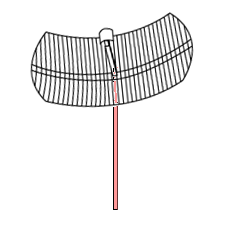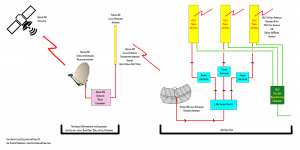On Friday, April 12, President Trump held a press event in the Roosevelt Room of the White House. His subject? 5G deployment. He remarks bear some close examination, as they come right out of the wireless industry playbook as enhanced by the FCC, a captured agency of that industry. Let’s take apart the remarks, which are copied here from WhiteHouse.Gov:
THE PRESIDENT: Well, thank you very much, everybody. Big day. Very important day. We have a lot of important days at our White House. And this is, to me, the future.
I want to thank you all for being here to discuss a critical issue for our country’s future: winning the race to be the world’s leading provider of 5G cellular communications networks. It’s all about 5G now. We were at 4G, and everybody was saying, “We have to get 4G.” And then they said, before that, “We have to get 3G.” And now we have to get 5G, and 5G is a big deal. And that’s going to be there for a while. And I guess, at some point, we’ll be talking to you about number 6. What do you think? (Laughter.) Do you think that’s true, Ajit?
As for the statement that we were at 3G, and we had to get to 4G, and now we must be at 5G, and perceptibly the president says that we’ll have to get to 6G (and if my math holds, 7G must follow 6G and so on…).
But, right now, we want to be the leader in this. We’re the leader in almost everything else.
And we’re grateful to be joined by FCC Chairman Ajit Pai, who’s been doing a fantastic job, and Deputy Secretary of Agriculture Stephen Censky. Thank you very much, Stephen. Appreciate it. And tell Sonny “hello.” He’s doing a tremendous job. Really tremendous.
Secure 5G networks will absolutely be a vital link to America’s prosperity and national security in the 21st century. 5G will be as much as 100 times faster than the current 4G cellular networks. It will transform the way our citizens work, learn, communicate, and travel. It will make American farms more productive, American manufacturing more competitive, and American healthcare better and more accessible. Basically, it covers almost everything, when you get right down to it. Pretty amazing.
American farms? Healthcare? Manufacturing? American farms in rural areas are largely waiting for full deployment of 3G, and for many 4G is a dream. The wireless industry has not seen fit to show how they will bring 5G wireless services to areas already grossly under-served. As for healthcare, and manufacturing, those market segments are fixed users who largely rely on the speed of fiber to power their user networks.
Certainly, 5G will aid “citizens work, learn, communicate, and travel” as soon as they (a) in areas with true 5G, and (b) have dropped a thousand dollars per device to buy phones and tablets that can utilize 5G.
And just as 4G networks paved the way for smartphones and all of the exciting breakthroughs — they made possible so many things — this will be more secure and resilient. 5G networks will also create astonishing and really thrilling new opportunities for our people — opportunities that we’ve never even thought we had a possibility of looking at.
I agree that 4G (and 3G before) have facilitated users to gain access to better APPs and 5G will do the same thing. As for being more secure and resilient, that’s a different ball of wax altogether. To be secure and resilient, you need to have and and control over the critical elements of the network. Notably, America does not have manufacturing capability for 5G networks. Huawei, the giant Chinese telecommunications firm thought to be controlled by or at least very friendly to the Chinese government, is a market leader in 5G switches and network components. If someone is going to monitor and control American 5G networks, I’d certainly prefer to see that monitoring and control in corporations that are fully aligned with U.S. interests.
We cannot allow any other country to out-compete the United States in this powerful industry of the future. We are leading by so much in so many different industries of that type, and we just can’t let that happen. The race to 5G is a race America must win, and it’s a race, frankly, that our great companies are now involved in. We’ve given them the incentive they need. It’s a race that we will win.
It’s hard to win a race when you’re not even competing in that race. To the extent that “our great companies are now involved in” this race, it’s hard to understand why we allow the coxswain to be a foreigner with suspect allegiances.
In the United States, our approach is private-sector driven and private-sector led. The government doesn’t have to spend lots of money. According to some estimates, the wireless industry plans to invest $275 billion in 5G networks, creating 3 million American jobs quickly — very quickly — and adding $500 billion to our economy.
Let’s do the math: $275B to create 3M jobs = nearly $92,000 per job to create. President Trump says nothing about the longevity of those jobs, much less anything about the jobs that may be lost to automation. Moreover, the $500 billion is, as some would call it, a completely disingenuous SWAG.
And, as you probably heard, we had another alternative of doing it; that would be through government investment. And leading through the government, we don’t want to do that because it won’t be nearly as good, nearly as fast. And especially in that business, I think that they’ll be better doing the job than a lot of the folks who we know and love.
I don’t suppose that President Trump truly knows, much less loves, the main wireless industry participants in the wireless facility builders. Most of us outside know them, but hardly love them.
To accelerate and incentivize these investments, my administration is focused on freeing up as much wireless spectrum as needed — we’re going to free it up so they’ll be able to get out there and get it done — and removing regulatory barriers to the buildout of networks.
As Chairman Pai will discuss with you in a moment, the FCC is taking very bold action — probably bolder than they’ve ever taken before; it’s a new frontier — to make wireless spectrum available. By next year, the United States is on pace to have more 5G spectrum than any other country in the world. That’s a big statement because, as you know, some people got ahead of us. We should have been doing this a long time ago, as advanced as it may be.
In addition, last October, I directed the Department of Commerce to develop a National Spectrum Strategy to free up even more spectrum for economic activity, including 5G.
The FCC has also taken action to streamline the permitting process for 5G infrastructure with state and local governments. That’s a big deal. It takes too long to get permits. We’re going to free that situation up, and we’re going to put limits and the local areas are going to listen to us very, very strongly. They have a big incentive to do that.
Yes, local governments have been listening, and so have the citizens, and what we hear is not very encouraging. We hear the wireless industry going from state to state incentivizing state legislators to enact laws that silence the public as to siting matters, and shift the cost of wireless deployment permitting from the remote shareholders of the wireless firms to the backs of the local public.
there is a lively and legitimate debate going on regarding how this next generation of wireless facility should be deployed, and where. It’s a debate that the wireless industry attempts to legislatively squelch.
They must now approve new physical infrastructure within 90 days, instead of many years. It can sometimes take three, four, and five years. We’re going to put a limit of 90 days. And there is now a cap on the unreasonable fees local governments often charge. They get greedy. They think, “Hey, we can really take advantage.” And it ends up that everybody gets hurt. So we’re putting a cap on those fees. These changes will contribute greatly to building high-speed networks across America. And it’s going to happen very quickly. Very, very quickly.
While the wireless industry, and the FCC, would prefer to focus on the relative handful of cases where permitting a wireless site took substantially longer than the average, and avoid at all costs understanding why that happens, the reality is just the opposite of what the president claims. As a practitioner in this area, I know that it commonly takes substantially less than a year to get a permit and often just a matter of a few months.
If charging fees to cover a local governments permitting costs are greedy, then the president does not understand (or want to understand) that process. This is unlike trying to secure permits for a midtown hotel, or a golf course, or a faux university. This is permitting for wireless facilities that will be in front of someone’s home for the next 50 years.
By the end of this year, the United States will have 92 5G deployments in markets nationwide. The next nearest country, South Korea, will have 48. So we have 92, compared to 48. And we’re going to accelerate that pace greatly.
That statement reminds me of Benjamin Disraeli’s quote about the three kinds of lies. (You can look it up.) Here, it’s enough to say that if you overlay the outline of the country of South Korea over a map of California, South Korea would take up less than half of California.
But we must not rest; the race is far from over. American companies must lead the world in cellular technology. 5G networks must be secure. They must be strong. They have to be guarded from the enemy — we do have enemies out there — and they will be. They must cover every community, and they must be deployed as soon as possible.
Finally, there’s something that a thinking person can agree with. Security, strength, guarding from the enemy, and coverage over every community. While the first three are agreeable and doable, it is a fantasy to believe that a free-market will see a truly national deployment that reduces the wireless divide between wealthy and poor, suburban and rural, city center and farming, etc.
Those are my opinions. What are yours?
Jonathan





 AT&T is filing applications with local governments to modify existing cell sites to add a wire frame parabolic antenna at some of its sites. The application also shows the addition of signal splitters (or combiners) and multiple power amplifiers. In the applications that I’ve seen so far, there’s no mention as to the service that is being provided by (or is it to) this new antenna.
AT&T is filing applications with local governments to modify existing cell sites to add a wire frame parabolic antenna at some of its sites. The application also shows the addition of signal splitters (or combiners) and multiple power amplifiers. In the applications that I’ve seen so far, there’s no mention as to the service that is being provided by (or is it to) this new antenna.